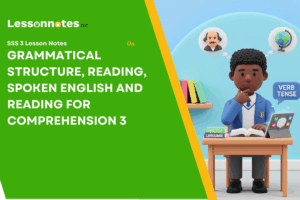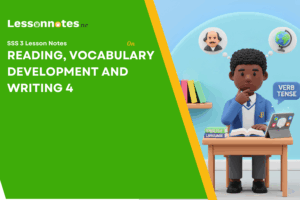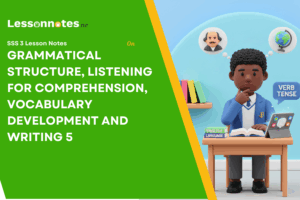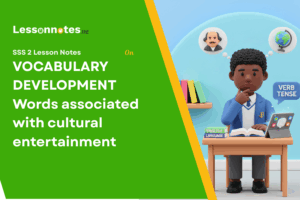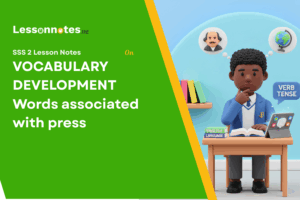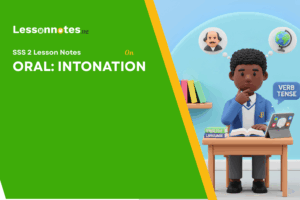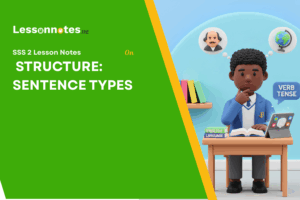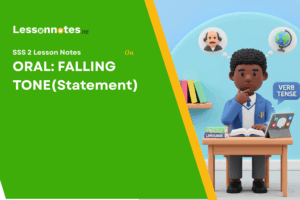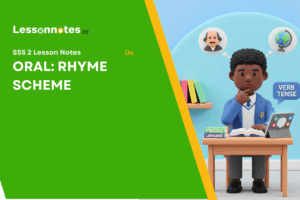Grammatical Structure, Writing And Comprehension 6 SS3 English Studies Lesson Note
Download Lesson NoteTopic: Grammatical Structure, Writing And Comprehension 6
GRAMMATICAL STRUCTURE
Complex Sentence
A complex sentence is a sentence that contains an independent clause and one or more dependent clauses.
Example:
If you aspire to grow in life, then change your mindset
In our class on conjunction, we spoke about the two major types of conjunction, coordinating and subordinating conjunction.
- Compound sentences are usually formed by combining two or more simple sentences (independent/main clauses) together with the aid of coordinators such as and, or, or but.
- Complex sentences, on the other hand, are commonly formed by linking two simple sentences (independent/main clauses) together with subordinating conjunctions such as when, because, that, so, which, etc.
See these examples:
1a.
Simbi will prepare the food.
- It is Simbi’s turn.=Simbi will prepare the food because it is her turn.
2a.
They fought yesterday.
- I saw them then.=I saw them when they fought yesterday.
3a. We left early.
- We wanted to get there on time.=We left early so we could get there on time.
Note that each resulting sentence here has two verbs or verb phrases. Let me point you to that
clearly:
- Simbi will prepare the food because it is her turn. (will prepare and is)
- I saw them when they fought (saw and fought)
- We left early so we could get there on time. (left and could get)
Anytime you see a sentence like that, there are two clauses therein. You recognize how many clauses a sentence has by counting how many verb or verb phrases are there in the sentence.
Did you get that?
Now pay close attention.
When you join clauses together with a subordinating conjunction (or simply subordinator), you make one clause depend (or rest) on the other clause, such that the dependent clause will not be able to stand alone except it depends (or rests) on that other clause.
So in the English Language, we call the clause that can stand alone independent (or main)
clause, and the one that cannot stand alone with dependent (or subordinate) clauses.
Did you get that?
If you don’t, read again from the examples above until you’ve understood every detail of what Ivjust explained it to you.
Now let’s go back to our examples above and break out the independent clauses from the
dependent clauses.
- Simbi will prepare the food /because it is her turn.
- I saw them when they fought yesterday.
- We left early/so we could get there on time.
Can you now recognize which one is the main clause and which one is the subordinate clause?
The first items before the slashes are the main (independent) clauses, while the boldface items (after the slashes) are the subordinate (dependent) clauses.
How did I know that?
It is simple. I know that because the boldface items all begin with a subordinator each:
because, when and so.
Notice that both types could be placed anywhere in the sentence, at the beginning or the end.
That means the subordinate clauses can come first in the sentences.
- Because it is her turn, Simbi will prepare the food.
- When they fought yesterday, I saw them.
- So we could get there on time, so we left early.
Notice that there is a need to insert the comma when the subordinate clause is placed first before the main clause as you have here.
Also, if we have enough space in a future class, I will tell you some other points to note about the complex sentence and the reason why people choose to place either the subordinate or main clause at the front and the other at the back.
General Evaluation
- Write a paragraph of words on any topic of your choice and underline, at least, five complex sentences in the paragraph.
- Look for an essay in your English Language past questions and write out 10 complex sentences you find in the essay.
WRITING
A report is a document that is presented in an organised manner, with the aim of passing information, checking data, and providing recommendations.
Reports are often used to communicate findings and outcomes to a specific audience, such as the important people in a company, who are also called stakeholders, or managers.
Reports can be different for many reasons, such as in length and in format but they usually contain a clear introduction, body, and conclusion.
Report Writing
Report writing is the process of creating a document that represents information in a clear and concise manner.
As we have come to know, report writing can primarily include writing for various purposes, such as providing updates on a project, analysing data, presenting findings, or providing suggestions.
To make a report, there are rules to follow. Just like you are supposed to obey the rules of the school, in report writing, obeying the rules helps you in making a good report.
This means that report-making requires careful planning, gathering information, explaining what you found and organised the information.
Before concluding your report, ensure you have written an accurate, and objective report containing a clear introduction, body, and conclusion.
Evaluation
- Mention two important uses of a report.
Reading Assignment
- Collect a copy of the report on your last school PTA meeting.
Weekend Assignment
- Identify three people that are likely to require a report.
COMPREHENSION
Comprehension is defined as the ability to understand something. Silent reading is defined as’ reading alone silently or done without speaking the words being read. Reading silently is considered remarkable. Then, topical materials for reading are those materials that one treats as a subject topic of discussion. Importance of silent reading
- It improves students’ understanding.
- It helps them concentrate on reading rather than pronunciation.
- It helps children to read faster and improve learning.
- It helps to develop reading skills.
- It helps them concentrate on understanding the content.
- It improves writing skills.
- It builds vocabulary.
Examples of topical materials
- Election
- Education
- Examination malpractice.



